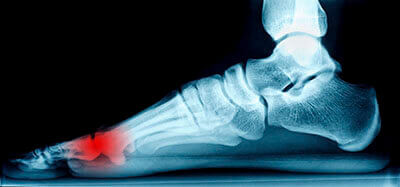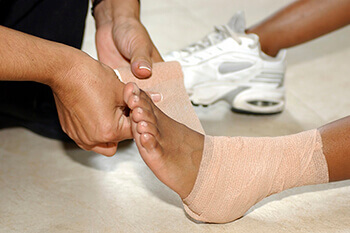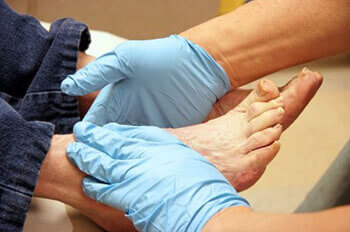Dallas (214) 340-8885
Athens (903) 677-9090
Gun Barrel City (903) 887-4341
Dallas (214) 340-8885
Athens (903) 677-9090
Gun Barrel City (903) 887-4341
 Morton's neuroma is a painful foot condition that commonly affects the areas between the third and fourth toe and the ball of the foot. Other areas of the foot can also be susceptible to this condition. Morton’s neuroma is caused by an inflamed nerve in the foot that is being squeezed and aggravated by surrounding bones. Women are more likely than men to have an occurrence of this foot condition. When a person has Morton's neuroma, it can feel as if they are walking on stones or marbles.
Morton's neuroma is a painful foot condition that commonly affects the areas between the third and fourth toe and the ball of the foot. Other areas of the foot can also be susceptible to this condition. Morton’s neuroma is caused by an inflamed nerve in the foot that is being squeezed and aggravated by surrounding bones. Women are more likely than men to have an occurrence of this foot condition. When a person has Morton's neuroma, it can feel as if they are walking on stones or marbles.
There are risk factors that can increase a person's chance of having Morton's neuroma. Ill-fitting high heels or shoes can add pressure to the toe or foot area. Jogging, running and any other sports that involve constant impact to the foot area can make a person more susceptible to this condition. If a person has flat feet, bunions or any other foot deformities, it can put them at a higher risk for developing Morton's neuroma.
There is no one major sign that indicates a person has Morton's neuroma, but rather certain symptoms to look for. A person who has burning in the ball of the foot or tingling and numbness in the toe areas are signs they may have Morton's neuroma. The pain increases greatly when wearing shoes or being active. There usually is little or no pain at night.
If a person suspects that they have this condition, they should visit their doctor. A physician will check for palpable masses between the bones of the foot. A doctor will also apply pressure to the foot or toe area to replicate the pain a person experiences when active. Range of motion tests and X-rays are other options a doctor may offer a patient to rule out other conditions or problems.
Treating Morton's neuroma can be as simple as changing the type of shoes a person wears. Wear wider shoes or flat shoes with a soft sole. Doing this may help reduce the pressure on the nerve that is aggravated. If necessary, a person can have a cortisone injection to help reduce swelling and pain in the foot area.
If these methods don't relieve the symptoms, consulting with an orthopedic surgeon should be the next option. During a consultation, a patient will find out about the treatment methods available for Morton's neuroma. A surgeon can release the tissue around the nerve that is causing this pain, or they can remove a small area of the nerve completely. There is a short recovery time for this type of surgery, and afterward, patients can return to their normal lifestyle.
 Ankle sprains can be quite the painful experience. Often times the injured person will experience limited mobility, swelling, and, depending on the severity, discoloration of the skin. This type of injury takes place when the ligaments are torn or stretched beyond their limits. Although this can occur in various areas of the body, the ankle is the most common site for a sprain.
Ankle sprains can be quite the painful experience. Often times the injured person will experience limited mobility, swelling, and, depending on the severity, discoloration of the skin. This type of injury takes place when the ligaments are torn or stretched beyond their limits. Although this can occur in various areas of the body, the ankle is the most common site for a sprain.
There are multiple ways that the ankle can become injured like this. However, the simple act of walking may cause a sprain. If footing is lost or the person is walking on uneven terrain, local damage may occur. This may be especially so for athletes that continually push their limits, or for the person who has suffered from a previous accident involving the lower extremities.
In the majority of cases, medical attention is not required for a sprained ankle. Remedies for self-care at home include propping the ankle up, applying ice packs as needed, and remaining off your feet. Some may also find that wrapping with an ACE bandage and taking over-the-counter pain relievers are helpful. One of the most important things is to avoid further stress to the affected area.
Although rare, complications may arise and obtaining medical treatment may become necessary. A severe sprain can actually tear the ligament and even damage the muscle. When this occurs, the person may have to be off their feet for a prolonged period of time. Depending on the severity and nature of the damage, surgery and physical therapy may be required. Seeking out a podiatrist will help in making these decisions.
Sprained ankles are painful in nature, but those with severe unrelenting pain may have sustained a worse injury than previously though. If walking becomes too painful for the person to take more than a few steps, swelling becomes too severe, or if numbness or tingling is present, immediate medical attention should be sought. Mild to moderate bruising is common with a sprain but redness of the skin or worsening of the discoloration should not persist either.
One of the best treatments for an ankle sprain is to prevent it in the first place. Wearing appropriate shoes for the occasion, stretching before exercises and sports, and knowing your limits can aid in prevention. Those that have suffered from a previous sprain may want to consider additional support, such as a brace and regular exercises to strengthen the ankle.
 Diabetes affects millions of people every year. Blood vessels located all over the body are damaged due to diabetes—even the blood vessels of the feet. Neuropathy, or nerve damage, can result from slower blood flow in the legs and feet. In diabetic patients neuropathy is very important to monitor, as diabetics are at risk for developing ulcers.
Diabetes affects millions of people every year. Blood vessels located all over the body are damaged due to diabetes—even the blood vessels of the feet. Neuropathy, or nerve damage, can result from slower blood flow in the legs and feet. In diabetic patients neuropathy is very important to monitor, as diabetics are at risk for developing ulcers.
Always washing and thoroughly drying the feet are pertinent parts of diabetic foot care. There should be a focus on cleaning between the toes. Even if no pain is felt, the entire foot should be examined for redness and sores. Neuropathy can often mask the pain of sores and ulcers, and cause these conditions to be overlooked. Use a mirror to examine the underside of your feet if needed. It is recommended that diabetics wear will-fitting socks.
Patients with diabetes should have their doctor monitor their blood levels because blood sugar levels play a huge role in diabetic care. Monitoring these levels on a regular basis is highly advised. It is very important to keep your blood sugar levels in the normal range, which can be determined by your physician. There are medications that a physician may prescribe to help with neuropathy of the diabetic patient. It is also advisable to visit a podiatrist if the diabetic patient is experiencing any conditions involving the feet such as ingrown toenails, which in more severe cases can cause infection.
Diabetic foot care at home is possible if a patient is provided with instructions from their physician. Patients can cure dry heels with creams or ointments. If trying to remove a callus with a tool, practice caution as severe diabetics may not be able to feel pain. Improper removal may cause a wound to develop.
Diabetic feet must be inspected on a daily basis. Set up regular visits with your podiatrist since proper diabetic foot care is necessary. If you suspect that you have a wound, notify your doctor immediately. Gangrene is a serious problem for diabetics and can lead to sepsis and amputation in its worst cases. Early treatment and daily inspection of diabetic feet are keys to staying healthy.
Jonathan M. Kletz, DPM, PA
Dr. Kletz received his undergraduate education at The University of Maryland and attended medical school at the Pennsylvania College of Podiatric Medicine. After graduating in 1989, he completed two years as a surgical resident in Dallas, Texas. Dr. Kletz is board certified as a foot and ankle surgeon by the American Board of Foot and Ankle Surgery. He is also a fellow of the American College of Foot & Ankle Surgeons. Dr. Kletz specializes in the medical and surgical treatment of foot and ankle conditions and has been in practice since 1991.